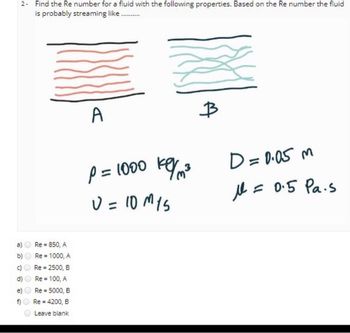
Introduction to Chemical Engineering Thermodynamics
8th Edition
ISBN: 9781259696527
Author: J.M. Smith Termodinamica en ingenieria quimica, Hendrick C Van Ness, Michael Abbott, Mark Swihart
Publisher: McGraw-Hill Education
expand_more
expand_more
format_list_bulleted
Question

Transcribed Image Text:2- Find the Re number for a fluid with the following properties. Based on the Re number the fluid
is probably streaming like..........
d)
e)
F
f)
Re-850, A
Re = 1000, A
Re = 2500, B
Re = 100, A
Re = 5000, B
Re = 4200, B
Leave blank
A
key/m²3
P = 1000 kg/m³
U = 10 M15
B
D = 0.05 m
= 0.5 Pa.s
Expert Solution
This question has been solved!
Explore an expertly crafted, step-by-step solution for a thorough understanding of key concepts.
This is a popular solution
Trending nowThis is a popular solution!
Step by stepSolved in 3 steps with 2 images

Knowledge Booster
Similar questions
- Look into the figure carefully to get the information.arrow_forwardConsider the flow of a fluid through the piping system shown below in Figure 1. m₁ m₂ ū₁ ū₂ (D: Diameter; a. Flow If D₁ = 4D2, determine the following: b. 1 Figure 1: Piping system (2) m: Mass flow rate; u: Average velocity) c. In which tube are we more likely to have a turbulent flow?arrow_forwardplease solve b and shows the stepsarrow_forward
- 5. Consider the problem of laminar, unidirectional flow in a pipe of radius a. Using the Navier- Stokes Equations: Solve for the velocity profile, u(r), in the pipe Calculate the maximum and bulk velocity (umax, ub) for this flowarrow_forwarda) (i) What are a Newtonian fluid and a -Newtonian fluid? Classify pendent non-Newtonian fluids and illustrate - flow time- behaviours in a diagram g. shear stress vs. shear (ii) across a flat plate and the s with the aid of a schematic diagram. Explain boundary concept for a flowarrow_forwardA. Suppose a free-fall ride at an amusement park starts at rest and is in free fall. What is the velocity of the ride after 2.3 s? How far do people on the ride fall during the 2.3 s time period?arrow_forward
- 1) Consider the infinitely tall, annular mixing tank. The fluid to be mixed is Fluid between the inner cylinder and the outer wall. The fluid is mixed by a Fluid spinning the inner cylinder at an angular velocity of n (s-1). The tank has an inner radius of R (m) and the R. inner cylinder has a diameter of k (m). Fluid There is no net flow in the vertical or radial directions. Top view Answer the following questions about Side view this sytem:arrow_forwardon problem B equation 1) what symbol is that? it looks like a N or an X , can you tell me the symbols for transport velocities and mass transfer thanks can you clarify more on what the symbolism is for that equationarrow_forward2. Adjacent Flow of Two Immiscible Power Law Fluids Two immiscible fluids are contained in the space between two infinite parallel plates. The upper plate, at y = h, is in motion with a velocity U. Initially there is no pressure gradient in the x-direction. We have already solved for the velocity profile between the two plates for a number of different conditions, now we are going to make fluid II non-Newtonian. U Fluid II Interface Between Two Immiscible Fluids ah Fluid I d) Go back to your old assignment (b), but now let's let Fluid II be non-Newtonian. Specifically, model the fluid as a power law fluid with n =ky". Solve for the velocity profile across the channel and sketch the result for a shear thinning and shear thickening fluid as the velocity on the top plate is systematically increased. e) Now remove the velocity of the top plate and instead apply a pressure gradient. What is the velocity profile look like now?arrow_forward
- What is the velocity (in cm/s) at radius r= 4.95 cm? What is the viscosity, mu (in g/(cm*s)) ?arrow_forwardA Newtonian fluid with constant density flows in a parallel-plate apparatus that separated by a distance d and length L as shown in Figure 1. The top plate is moving in z-direction with a velocity uw. Derive the velocity distribution of the fluid, vz as a function of y using equation of motion in Appendix 1. List the postulates and you may neglect the gravity force.arrow_forward
arrow_back_ios
arrow_forward_ios
Recommended textbooks for you
 Introduction to Chemical Engineering Thermodynami...Chemical EngineeringISBN:9781259696527Author:J.M. Smith Termodinamica en ingenieria quimica, Hendrick C Van Ness, Michael Abbott, Mark SwihartPublisher:McGraw-Hill Education
Introduction to Chemical Engineering Thermodynami...Chemical EngineeringISBN:9781259696527Author:J.M. Smith Termodinamica en ingenieria quimica, Hendrick C Van Ness, Michael Abbott, Mark SwihartPublisher:McGraw-Hill Education Elementary Principles of Chemical Processes, Bind...Chemical EngineeringISBN:9781118431221Author:Richard M. Felder, Ronald W. Rousseau, Lisa G. BullardPublisher:WILEY
Elementary Principles of Chemical Processes, Bind...Chemical EngineeringISBN:9781118431221Author:Richard M. Felder, Ronald W. Rousseau, Lisa G. BullardPublisher:WILEY Elements of Chemical Reaction Engineering (5th Ed...Chemical EngineeringISBN:9780133887518Author:H. Scott FoglerPublisher:Prentice Hall
Elements of Chemical Reaction Engineering (5th Ed...Chemical EngineeringISBN:9780133887518Author:H. Scott FoglerPublisher:Prentice Hall
 Industrial Plastics: Theory and ApplicationsChemical EngineeringISBN:9781285061238Author:Lokensgard, ErikPublisher:Delmar Cengage Learning
Industrial Plastics: Theory and ApplicationsChemical EngineeringISBN:9781285061238Author:Lokensgard, ErikPublisher:Delmar Cengage Learning Unit Operations of Chemical EngineeringChemical EngineeringISBN:9780072848236Author:Warren McCabe, Julian C. Smith, Peter HarriottPublisher:McGraw-Hill Companies, The
Unit Operations of Chemical EngineeringChemical EngineeringISBN:9780072848236Author:Warren McCabe, Julian C. Smith, Peter HarriottPublisher:McGraw-Hill Companies, The

Introduction to Chemical Engineering Thermodynami...
Chemical Engineering
ISBN:9781259696527
Author:J.M. Smith Termodinamica en ingenieria quimica, Hendrick C Van Ness, Michael Abbott, Mark Swihart
Publisher:McGraw-Hill Education

Elementary Principles of Chemical Processes, Bind...
Chemical Engineering
ISBN:9781118431221
Author:Richard M. Felder, Ronald W. Rousseau, Lisa G. Bullard
Publisher:WILEY

Elements of Chemical Reaction Engineering (5th Ed...
Chemical Engineering
ISBN:9780133887518
Author:H. Scott Fogler
Publisher:Prentice Hall


Industrial Plastics: Theory and Applications
Chemical Engineering
ISBN:9781285061238
Author:Lokensgard, Erik
Publisher:Delmar Cengage Learning

Unit Operations of Chemical Engineering
Chemical Engineering
ISBN:9780072848236
Author:Warren McCabe, Julian C. Smith, Peter Harriott
Publisher:McGraw-Hill Companies, The